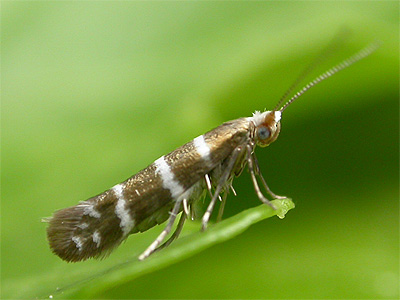

| Eakring Moths 2000 |
| A summary of the year |
| A lot of work went into
the recording of the area's moths during the latter half
of the flight season. Much still remained to be done by
the end of the year, but many species were identified and
listed during the course of the late Summer and Autumn. Coverage certainly turned up some interesting species and one of the records may well prove to be firsts. This is the case for a rather insignificant looking micro, Argyresthia trifasciata shown on the right. The case of the probable single specimen of A. trifasciata, only came to my notice towards the end of the year, having been contacted by M.Honey of the Natural History Museum in London, stating that the record could well be a Vice County first. The potential importance of this find remained unknown until then, but is likely to remain unconfirmed, due to a lack of any specimen. |
 |
|
| .... | ||
| Perhaps the
most exciting discovery was the migrant Hummingbird
Hawk-moth Macroglossum stellatarium,
which was at Eakring village on July 2nd. A large
invasion of the migrant Silver-Y moth during 2000, meant
that this became one of the commonest species within the
area during the late Summer and a three figure count at
Oil Bore Holes was just a small percentage of the large
population present. Two of the more commoner species found here are Silver Ground Carpet and Common Carpet. Both were fairly widespread throughout the area. Large populations of the Magpie and Common Wainscot also existed, alongside smaller numbers of regularly caught species like Setaceous Hebrew Character, Square-spot Rustic, Brimstone Moth and Mother of Pearl. September saw some interesting species on the wing. One of the commonest being the Lunar Underwing , which occupied many parts of the area. Garden Rose Tortrix was another easily found species. Undoubtable highlight however, was the capture of an adult Rusty Dot Pearl Udea ferrugalis, near Eakring Flash. |
||